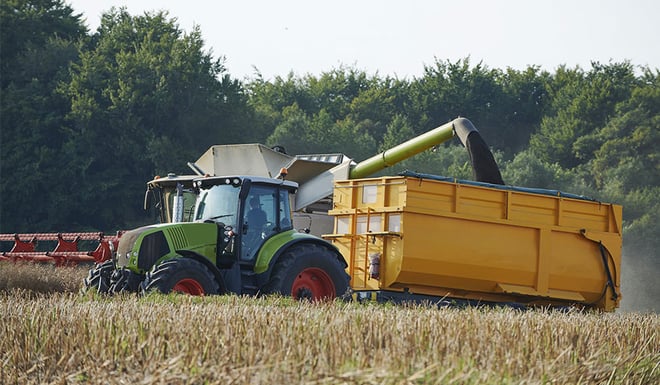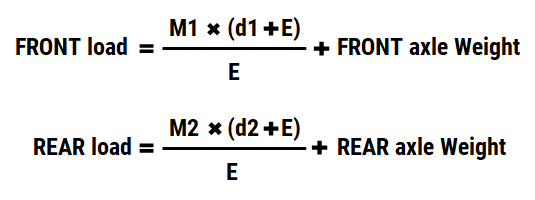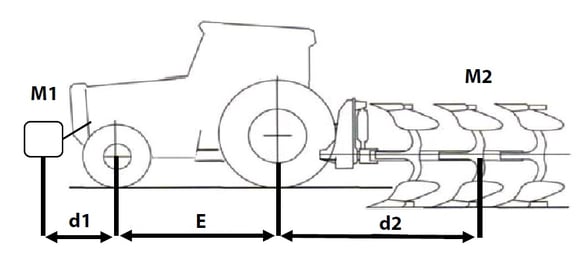Your existing implements have a pre-defined weight which you cannot change, and if you buy new implements they will logically be bigger to improve productivity and therefore certainly heavier.
If you cannot modify the weight of each implement, you will have to compensate for this load by increasing the air pressure in your tyres. This is the usual choice that is made with standard tyres, increasing inflation pressure to avoid the tyres being crushed under the weight of the load, yet there are many drawbacks to this solution: slip, soil compaction, increased fuel consumption.
There is another solution directly linked to tyres to increase the load and reduce inflation pressure at the same time. In this article we look at how to achieve this.
1. How much load can standard tyres carry?
Due to their reasonable price, standard tyres are quite logically the most commonly used at present, but they do not always allow you to carry sufficient loads, which can have a negative impact on your tractor’s efficiency.
For standard tyres, just like any other tyre model, you can find the load index corresponding to a maximum speed marked on the sidewalls. This has been established by the manufacturer based on the level of technology and the tyre’s structure (radial or bias-ply).
If you are transporting a load that is too heavy for your tyre model, you will be obliged to increase inflation pressure to the maximum, which will result in premature wear, forcing you to buy a replacement tyre rapidly which is not very cost-efficient.
At the very least when using standard tyres, you must respect the correct pressure levels for the load you intend to carry. The pressure must be accurately adapted to:
- The load on each axle (different at the font and at the rear depending on your implements)
- A maximum speed that you must not exceed
- Estimated torque (high or low depending on the work to be carried out)
- The type of ground (transport by road, work in the fields, etc.).
How do I calculate the load with the implement?
As each implement has a different weight which is transferred to your tyres, it is necessary to calculate the load every time you change implement.
The load index marked on your tyres gives you a precise limit that must not be exceeded. This information provided by the manufacturer allows you to define the weight of the implements that you can use on your tractor equipped with standard tyres, or the maximum possible weight for your trailers.
There are two ways to calculate the load on each tyre.
With weighing equipment:
- Weigh the front axle: the rear implement must be placed in working position.
- Weigh the rear axle: the implement must be raised.
- Ballast the front of the tractor: to rebalance the load distribution.
- Check the result with the ballasting: the weight obtained must not exceed the load index marked on your tyres.
- Adjust pressure: the pressure setting must take account of the weight measured and the maximum speed intended.
Without weighing equipment:
If you don’t have weighing equipment, you can calculate the load on each axle using the information provided by the manufacturer, by taking a few simple measurements.
You can calculate the weight on each axle using the following formula:
You will need the following information for the calculation:
- M1: weight of front ballast (or front implement).
- M2: weight of the rear mounted implement (manufacturer data).
- d1: distance between the centre of the front ballast (or centre of the front implement) and the middle of the front axle.
- d2: distance between the centre of the rear axle and the centre of the rear mounted implement.
- E: distance between the middle of the rear axle and the middle of the rear axle.
- Weight front axle: tare weight of the front axle (manufacturer data).
- Weight rear axle: tare weight of the rear axle (manufacturer data).
In which cases should you adapt inflation pressure despite the load being the same?
This is one of the main drawbacks of standard agricultural tyres, their pressure settings are different for use on the road and in the fields. Inflation pressure must be adapted for each type of use to avoid premature wear to your tyres, or even damaging your soil and as such having a long-term effect on your productivity.
What is the impact of the load on my standard tyres during use on the road?
During trips by road, the drawn implement is generally raised, which generates a massive load transfer to your tractor’s rear axle. In addition, travel by road is at high speed. The sudden extra load, plus the speed, will invalidate your prior pressure settings, which were linked solely to load.
Roads have a hard abrasive surface which wears the tread of standard tyres rapidly if the pressure settings are incorrect.
To reduce rolling resistance on the asphalt, and thus limit tyre wear, it is recommended to increase inflation pressure slightly compared to the pressure defined by your load calculation.
What is the impact of the load on my standard tyres during use in the fields?
While it is recommended that you overinflate your tyres on the road, you must, on the contrary, reduce pressure when working in the fields.
Incorrect inflation pressure and excess loads borne by standard tyres will:
- Cause excessive soil compaction.
- Encourage the formation of ruts.
- Lead to excess fuel consumption.
A lower inflation pressure is possible with standard tyres because the speed is reduced in the fields, allowing a larger soil footprint, thus reducing slip.
However, you must check that the load is in line with the reduced speed, to remain within your tyre’s tolerance capacity. However, this option will oblige you to drive at reduced speed during deliveries by road.
2. What level of load is possible with VF technology tyres?
There are more efficient and more resistant tyres than standard tyres. These are VF technology (Very High Flexion) tyres. They are designed to bear heavier loads and their main characteristics are their ability to flex and deflect.
In the fields, they can be used at as little as 0.8 bar without difficulty, which is more complicated for standard tyres which in general have to comply with minimum pressure settings of over 1.2 bar when loaded.
The main advantage of the VF tyre is that it can bear greater loads, of up to 40% more weight than classical tyres of the same size.
Example of weighing a 305CV Fendt 930 tractor (total weight of the tractor without implements = 12,260 kg) with low-pressure VF VT-TRACTOR tyres and equipped with a seeder:
- Front dimension: 600/65 R34 VT-Tractor
- Rear dimension: 710/70 R42 VT-Tractor
- Seeder dimension: 540/65 R24.
 Weighing the rear axle to define the load transfer
Weighing the rear axle to define the load transfer
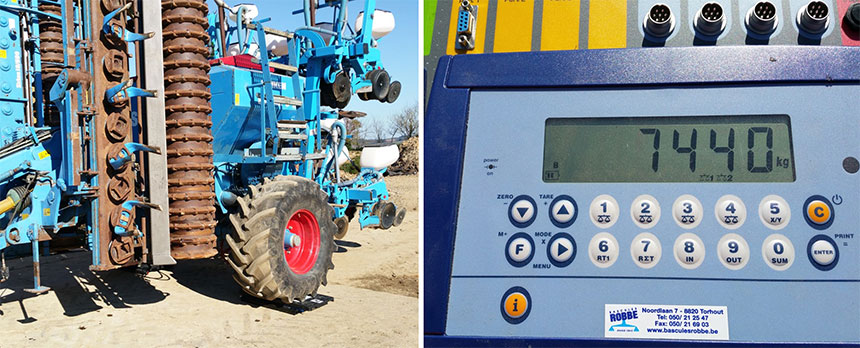 Weighing the empty seeder at 7,440 kg
Weighing the empty seeder at 7,440 kg
The result of this weighing operation allows us to define the load transfer to the rear axle of the tractor. Depending on this load, we can define the inflation pressure which will be 0.8 bar for the rear axle with VF tyres and 1.5 bar with standard technology tyres (i.e. almost double the pressure) with the same size tyre.
The VF tyre will therefore allow you to work with heavier implements, without too high an inflation pressure, whereas the standard tyre would rapidly reach its maximum inflation pressure.
With the same load, the VF tyre creates less soil compaction
It is possible to increase the load without increasing the inflation pressure by opting for low-pressure VF tyres. With the same tyre dimension, the VF tyre can work at a lower inflation pressure, thus preserving your soil from compaction, especially in wet conditions.
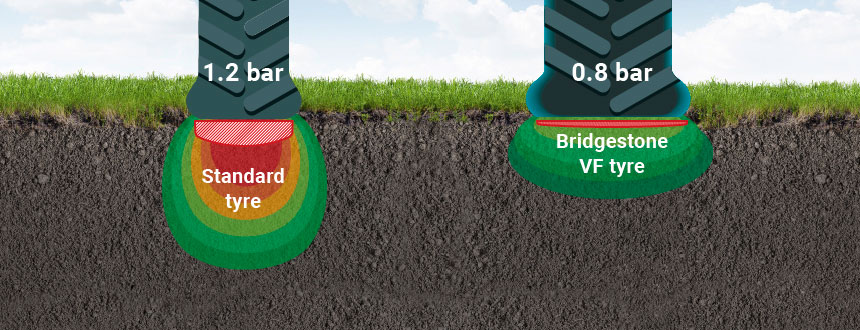 Comparison of the impact of the same load on the ground depending on the tyre model
Comparison of the impact of the same load on the ground depending on the tyre model
VF tyres provide a better distribution of weight to the ground thanks to their larger contact patch.
VF agricultural tyres such as the VT-TRACTOR make it possible:
- To increase the load.
- To limit soil compaction.
- To reduce slip.
- To improve traction.
- To save on fuel.
- To make trips by road without adapting inflation pressure.
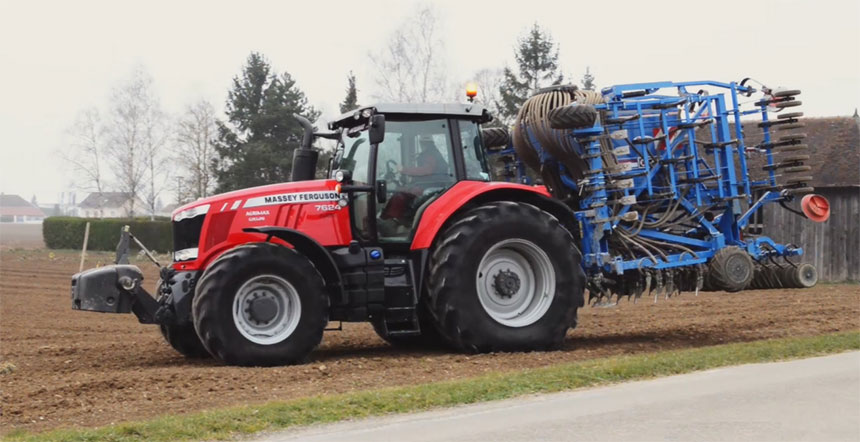 Massey Fergusson equipped with low-pressure VF VT-TRACTOR tyres
Massey Fergusson equipped with low-pressure VF VT-TRACTOR tyres
What are the right habits to adopt in the event of intensive road travel with VF tyres?
VF tyres are highly appreciated for their ability to save time. Unlike standard tyres, these more resistant high-tech tyres can drive with the same pressure on the road and in the fields. You therefore don’t need to worry any more about adjusting pressure settings when you go from one type of ground to another (asphalt, soft soil).
Nevertheless, you must take into account your speed on the road, because beyond a certain limit, increasing inflation pressure is still highly recommended. This is especially the case if you drive at over 50 km/h.
On the other hand, you can maintain the pressure you defined beforehand based on your weight measurements (tractor + implements) when you drive at a moderate speed of around 30 km/h.
The Bridgestone-agriculture.eu blog is written and administered by tractor tyre experts who are available to provide you with the advice you need on the subject of your agricultural tyres. They allow you to maximise your productivity with information on all subjects linked to tyres: Cheap tractor tyres — Technical data for agricultural tyres — Air pressure advice — Solutions to avoid soil compaction — Sprayer tyre pressure — Why and how to ballast your tractor tyres — When to use dual wheels — The mechanical causes of abnormal wear — Cheap agricultural tyres – etc.
To learn more and boost your farm's profits, Bridgestone-Agriculture is offering you a free, detailed white paper that explains the essential role your agricultural tyres play in your productivity.
Most people who read this article have also read some of the following articles:
- 5 essential techniques to optimise your agricultural tyres
- How to maximise traction with my tractor tyres
- Agricultural contracting companies: improve team awareness about tyres
- Equipment sharing cooperatives: How to manage the agricultural tyre budget?
- Duals or low-pressure agricultural tyres: which to choose?
- What is the maximum load that your tractor tyres can carry?
- How do you ensure that your tractor tyres have a good self-cleaning capacity?
- Agricultural tyre evolution, what impact on my farm?
- Agricultural contractors: improving quality of service with an adapted agricultural tyre
- Which vibrations are directly linked to agricultural tyres?
This information is intended only to make you aware of the technical and functional aspects of agricultural tires and their use. It does not allow you to make a judgment or a definitive conclusion on a given problem. Only your agricultural tire expert is able to make a technical assessment and take a final decision, case by case.
Leave a
commentary
Your email address will not be published.
Required fields are indicated with *


